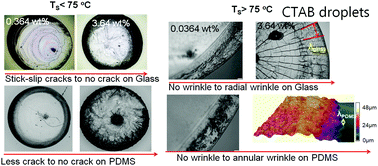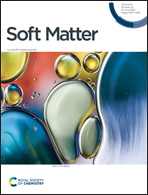Scaling mechanical instabilities in drying micellar droplets†
Abstract
Drying-induced mechanical instabilities in aqueous solution droplets occur primarily because, during evaporation, the central liquid minimizes the surface tension by pulling the packed gel-like region, leading to a stretching effect of the liquid region at the receding wet front. Under an appropriate scenario, it finally perturbs the gel-like zone at the droplet periphery, generating cracks, wrinkles, folds, cavities, buckles, etc. Here we report unique wrinkling patterns from evaporating sessile micellar aqueous droplets on rigid and soft substrates kept at temperatures well above the ambient. The wrinkling patterns remarkably vary depending on the material's elastic modulus and substrate, the concentration of the micellar solution (CCTAB), and the substrate temperature (TS). In the low concentration regime (CCTAB ≤ 0.0364 wt%), coffee-ring-like morphologies are observed devoid of any wrinkling morphology irrespective of TS and the substrate's elastic modulus. In the high initial concentration regime (CCTAB ≥ 0.0364 wt%), for droplets deposited at TS ≥ 85 °C, wrinkle formation starts at the droplet peripheral zone, radial on the stiff glass substrate, and annular on the soft cross-linked PDMS substrate. At CCTAB ≥ 2.73 wt%, radial wrinkles on the glass substrate and annular wrinkles on the cross-linked PDMS substrate nucleate from the edges connecting to the central region of the deposit. The ratio between the width of the gel-like deposit (or wrinkle length) and the droplet's radius scales with the initial concentration of the surfactant and depends on the initial equilibrium contact angle of the micellar droplets. Our results support existing understandings of mechanical instabilities of dried deposits, which satisfies interdependent scaling relationships among their number, lengthscale (dried deposit radius, the wavelength of the wrinkles, and peripheral undulations from Rayleigh–Bénard instability), thickness, and elastic modulus. Interestingly, we found substrate-dependent antagonistic interdependence of the elastic modulus of the dried deposit with the initial surfactant concentration.



 Please wait while we load your content...
Please wait while we load your content...